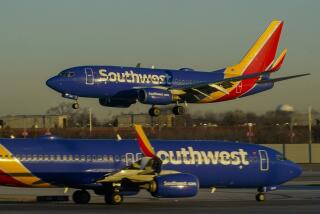Southwest’s Key Indicator of Performance Decreases : Airlines: Carrier’s yield--a gauge of passenger revenue per mile--is down. So too are growth, percentage of seats filled.
- Share via
DALLAS — Competition on the West Coast and scattered fare sales across its routes have pushed down a key indicator of financial performance at Southwest Airlines Co.
Southwest, which has 17 daily flights from Orange County’s John Wayne Airport, expects its yield--an expression of revenue per passenger mile--to decline in the fourth quarter. It wouldn’t say by how much.
Industrywide discounting is the chief reason, said Gary Kelly, chief financial officer, as well as a slow start-up of service in the Pacific Northwest and Salt Lake City. He expects that latter trend to reverse with the beginning of ski season.
In the year-ago quarter, Southwest’s yield was 11.93 cents, Kelly said. Southwest’s yield for the first nine months of the year was 11.70 cents compared with 11.72 cents in the 1993 period.
In addition, Southwest’s traffic hasn’t sustained its usual pace of 15% or so growth. While last month’s traffic was up 9.5%, load factor--the percentage of seats filled--fell three points to 65%. Kelly said 1993’s load factor was extraordinarily high, and “to be at 65 this year is nothing to be ashamed about.” The company has said November’s load factor isn’t likely to match the year-ago 65.9%, either.
Southwest’s response to the declining yields and load factor has been its own selected fare sales to stimulate traffic, including reinstituting its 21-day advance purchase fare; a special half-off promotion from certain cities; and a $99 fare in other markets. And last week it sent frequent fliers a special offer: Fly three round trips by February and get a free trip.
Despite the pressure on its revenue, Southwest has had success holding back costs.
Last week, the company announced it reached agreement with its pilots for a new 10-year contract under which the pilots will get no wage increase for the first five years, although they’ll get profit sharing.
Southwest has also cut the percentage of tickets sold through travel agents in the most recent quarter to 47% from 55%. Major airlines typically sell 80% of their tickets through travel agents, who get a 10% commission on the cost of the ticket. The drop means Southwest now captures more revenue per ticket, although it is paying more than it did to mail out tickets to passengers.
“The net result is an enormous increase in ticket by mail volume,” Kelly said. “We’ve captured a lot of direct business we otherwise wouldn’t have.”
The airline also is experimenting with a ticketless system on some flights, particularly in California where it is competing head-to-head with UAL Corp.’s West Coast shuttle. Fewer than 20% of Southwest customers use ticketless systems where available, and the airline is putting it in place slowly to avoid technical problems.
More to Read
Inside the business of entertainment
The Wide Shot brings you news, analysis and insights on everything from streaming wars to production — and what it all means for the future.
You may occasionally receive promotional content from the Los Angeles Times.










